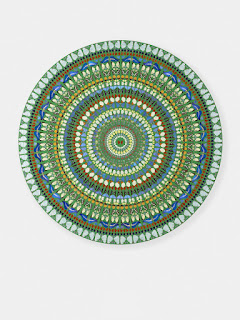'I've got an obsession with death... But I think it's like a celebration of life rather than something morbid.' - Damien Hirst
With the memory of my visit to the Butterfly Biosphere (here) last month still fresh in my mind, and the sheer variety of butterflies housed within, full of life, delightfully flitting about the dome, it was off to White Cube, Mason's Yard. I had heard that Damien Hirst was having his first major London show in seven years consisting of a new series of butterfly works entitled Mandalas. The butterflies found here though were in stark contrast, lifeless, dismembered, having given up their wings for the sake of being immortalised in the name of art. These Mandalas continue the theme of Hirst's earlier Kaleidoscope series. The Mandalas are made up of exquisitely arranged concentric circles of butterfly wings set into a backdrop of household gloss paints. These Mandalas are ambitiously large in scale, given the aid of the hired help from Hirst's army of studio assistants, and are hypnotically mesmerising given their meticulous rythmic layouts, enticing colours, and the gorgeous, natural iridescence and lustres of the various species of butterfly wings he has employed. Hirst has recieved some flack from critics over the ethics of the sourcing of the butterflies in the past, and more recently with these new works about the validity of his appropriation of the ancient Eastern philosophical and spiritual practices which were behind the inspiration of these works. Critics cite the disparity in the vast wealth that Hirst has accrued by the (cynical?) commodification of elements of his oeuvre from the spot paintings, to the cow, fly, shark and butterfly corpses, and that he now wants us to believe that that there is an inherent spirituality in these works given the stratospheric prices he and his gallery command for them. There is perhaps certainly a case against these butterfly mandala works when the latest report from State of Nature declares that more than two-fifths of UK animal species have significantly declined, with butterflies and moths being particularly hard hit with their numbers falling by 17 per cent and 25 per cent respectively. I guess being as powerful a personage in the art world as Hirst is, grants him an immunity from certain sections of criticism. Whether you like Hirst's work or not though, there is no denying the appeal and power of these works. The iridescent silvery blue sheen of the Morpho butterfly wings is particularly gorgeous as they catch the light. Hirst has fired the imaginations and creativity of many an artist currently utilising the butterfly motif and these works are quite mesmerising to behold.
Damien Hirst - Mandalas
until 2 November
White Cube
25-26 Mason's Yard
St James's
London























